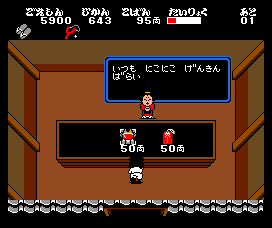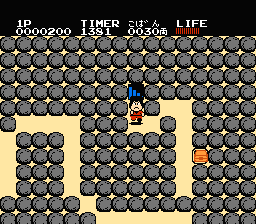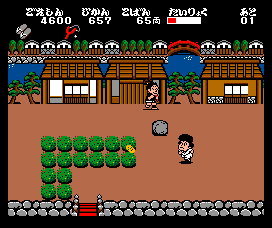Retro Replay Review
Gameplay
Ganbare Goemon! Karakuri Dōchū combines straightforward beat ’em up action with a dash of maze-like exploration to keep players on their toes. As Goemon, you move through side-scrolling stages set in a stylized feudal Japan, dispatching foes with well-timed swings of your trusty smoking pipe. The core combat loop is simple but satisfying—button mashers will enjoy the flurry of hits, while more deliberate players can time counters and aerial combos to clear rooms efficiently.
(HEY YOU!! We hope you enjoy! We try not to run ads. So basically, this is a very expensive hobby running this site. Please consider joining us for updates, forums, and more. Network w/ us to make some cash or friends while retro gaming, and you can win some free retro games for posting. Okay, carry on 👍)
What sets Karakuri Dōchū apart is its light RPG mechanics and stage puzzles. Enemies drop coins when defeated, and scattered throughout each area are small shops where you can spend your loot on weapon upgrades or health-restoring items. These shops force you to make strategic choices: do you save up for a powerful pipe upgrade or stockpile healing items for tougher boss encounters? It’s reminiscent of River City Ransom’s economy, but wrapped in a distinctly Japanese aesthetic.
The level design injects a maze-solving element that balances out the hack-and-slash action. Rather than following a strictly linear path, you often have to explore branching corridors, hit hidden switches, or find keys to unlock gates. This exploration adds variety but also a bit of trial-and-error; be prepared to backtrack if you miss a crucial item or door trigger.
A notable feature is the hot-seat alternating two-player mode. While only one Goemon can roam the screen at a time, players take turns whenever one character falls or reaches the end of a stage. This approach encourages friendly rivalry—competing to see who can rack up more coins or clear rooms faster—without splitting the screen or lessening the on-screen action.
Graphics
For its era, Karakuri Dōchū presents a colorful and charming depiction of feudal Japan. The character sprites are large and expressive, with Goemon’s signature blue-and-white outfit easily recognizable against the vibrant backgrounds. Enemies range from ragtag bandits to mythical creatures, each rendered with enough detail to stand out in the heat of battle.
The environments showcase a variety of locales: bamboo forests, mountain passes, seaside towns, and traditional castle interiors. While the hardware limitations of the time mean there’s little in the way of parallax scrolling or advanced lighting effects, each stage boasts a distinct palette and thematic decorative touches—paper lanterns sway, wooden gates creak, and distant mountains loom in the background.
Sprite animations are smooth, particularly Goemon’s pipe swing and acrobatic jumps. Enemy movements can feel a bit repetitive—many share similar walking cycles—but boss characters often receive more elaborate frames of animation, underscoring their heightened threat. Shop screens and item icons are cleanly designed, making it easy to identify upgrades at a glance.
Technical limitations do occasionally rear their head: flicker can occur when too many sprites gather on screen, and collision boxes sometimes feel a pixel off, leading to frustrating hits from unseen projectiles. Yet for retro enthusiasts, these quirks add to the game’s nostalgic charm rather than detract from it.
Story
Storytelling in Karakuri Dōchū is light on dialogue but heavy on atmosphere. The basic premise—Goemon traveling across feudal Japan to rid the land of bandits and malevolent warlords—serves as a simple framework to justify the action. Between levels, brief text screens set up the next location or introduce a new antagonist, keeping the pace brisk and the focus squarely on gameplay.
Though there’s no voice acting or cinematic cutscenes, the game evokes classic Japanese folklore through its stage names and enemy designs. You’ll face ninjas, oni (demons), and supernatural guardians guarding key items. Each new region feels like a chapter in a larger journey, and collecting hidden relics or townfolk’s lost trinkets adds small side-story beats that flesh out the world.
Character development is minimal, but Goemon’s silent-protagonist charm shines through his actions—rescuing villagers, smashing treasure chests, and exchanging winks with shopkeepers. In two-player mode, Ebisumaru joins the fray as a palette-swapped sidekick, offering brief moments of banter via single-screen text prompts.
For a title released in the late ’80s, the narrative ambition is modest yet effective: it situates players in a vibrant, slightly fantastical version of Japan without slowing down the combat-heavy gameplay. Fans of more story-driven adventures may find it sparse, but as a backdrop for action, it delivers just enough context to keep you invested.
Overall Experience
Ganbare Goemon! Karakuri Dōchū is an inventive blend of beat ’em up thrills and light puzzle exploration that still holds up for fans of retro action games. Its simple combat mechanics are immediately accessible, yet the hidden pathways and shop economy introduce strategic depth. Whether you’re a completionist hunting every secret or a casual player barreling through on pure reflex, there’s enjoyment to be found.
The difficulty curve can be sharp: some maze segments require meticulous searching, and boss fights demand pattern memorization. Passwords (or limited continue systems, depending on the port) help mitigate frustration, but newcomers should be prepared for occasional trial-and-error. Those who relish old-school challenges will appreciate the sense of accomplishment when they finally clear a tough stage.
Replay value is boosted by the two-player hot-seat mode and the pursuit of high coin totals to unlock all upgrades. Speedrunners and completionists will find reasons to revisit stages, whether to shave seconds off their time or to ensure no scroll or power-up was missed. The game’s compact size makes it ideal for quick pick-up sessions, but there’s enough content to sustain a longer playthrough.
In sum, Karakuri Dōchū stands as an important origin point for the beloved Ganbare Goemon series. It may lack the polish and breadth of later entries, but its unique hybrid of action, exploration, and light RPG elements provides a memorable experience. Retro enthusiasts, fans of Japanese folklore, and players seeking a different take on side-scrolling beat ’em ups will find this title both charming and engaging.
 Retro Replay Retro Replay gaming reviews, news, emulation, geek stuff and more!
Retro Replay Retro Replay gaming reviews, news, emulation, geek stuff and more!









Reviews
There are no reviews yet.